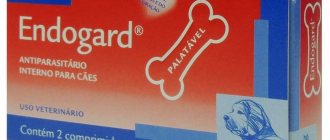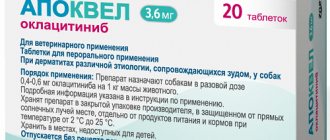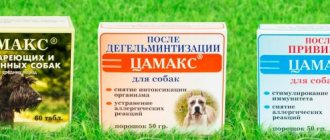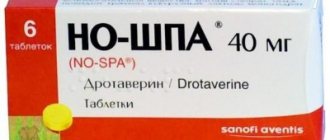In this article I will talk about the use of smecta in dogs. I will describe the composition of the drug, release form, mechanism of action and indications for use. I will explain how to determine the dosage and give it to the dog. I will give possible side effects and contraindications for use. I will write down the storage conditions for the medicine and expiration dates, prices in the pharmacy and possible analogues.
Smecta is an antidiarrheal adsorbent agent and is an aluminosilicate of natural origin. Also used for cats.
Composition and therapeutic effect
The powder, which is sold in pharmacies and is actively used in official medicine, is nothing more than diosmectite, a compound of magnesium and aluminum. The composition also includes auxiliary components and flavorings. The sorbent has an enveloping effect, thanks to which it protects the mucous membranes of the stomach and intestines from toxins, the negative effects of bile and acids.
Smecta is used for diarrhea, bloating and abdominal pain, and poisoning. It reduces the absorption of toxins and irritation of the mucous membrane of the esophagus, stomach, and intestines. Diosmectite helps collect and remove pathogens from the food tract and the animal’s body.
The medication is safe for dogs, therefore it is often used as first aid for loose stools and abdominal pain in a pet, however, if there are dangerous symptoms indicating a viral, infectious nature of the disease, severe intoxication of the body, you should not self-medicate, but immediately contact a veterinarian clinic.
Reviews
Dog owners who resorted to using Smecta for diarrhea in dogs left many comments. According to them, improvement in the pet’s condition after taking the drug occurs much faster than without the use of any means. The powder for preparing the suspension is not expensive, so absolutely everyone can afford it to treat their dog. Pet owners also appreciated the fact that the powder consists of components of natural origin and therefore does not harm the body.
Breeders and ordinary dog owners recommend Smecta!
Purpose
Intestinal upset and loose stools can be caused by many reasons. In puppies, this can be normal overeating; in adult dogs, it can be a change in diet, helminthic infestation, infection with pathogens, an allergic reaction, or stress. Veterinarians recommend giving Smecta to pets if they have the following symptoms:
- diarrhea, including of unknown origin;
- abdominal pain, bloating, rumbling;
- nausea, vomiting caused (even presumably) by poisoning;
- inflammation of the esophageal mucosa (esophagitis), which is manifested by refusal to eat, weight loss, and pain in the cervical region of the esophagus upon palpation.
The sorbent will help the animal get rid of pain and rumbling in the stomach, increased gas formation that accompany diarrhea. It is used as part of complex therapy for acute and chronic diarrhea caused by food allergies and long-term use of certain medications. Smecta will also help get rid of heaviness in the stomach after overeating, which is usually typical for small puppies who do not know the feeling of fullness.
Important! Smecta will not help, and you should immediately contact your veterinarian if blood is found in the stool. The reasons can be different - from penetration of a foreign object into the gastrointestinal tract, which caused intraintestinal bleeding, to dangerous diseases - enteritis, plague.
Diarrhea always accompanies poisoning. On the one hand, frequent bowel movements help remove harmful toxins. On the other hand, beneficial microorganisms leave the body along with feces, while pathogenic ones develop faster. Dysbacteriosis leads to weakening of the entire body. In case of poisoning by poor-quality food or chemicals, the sorbent will protect the mucous membrane of the stomach and intestines from the aggressive effects of toxins and will help quickly remove poisons from the body.
Important! Prolonged diarrhea can cause dehydration, so if anti-diarrheal medications do not help, you should contact your veterinarian.
What side effects may occur?
Smecta consists of natural components, so it has virtually no side effects or contraindications. However, even this safe drug can harm the dog if the permissible dosage is exceeded. The only consequence is constipation, which goes away after stopping the medication or reducing the dose.
If constipation continues for more than 8 hours, you need to give the animal a little Vaseline oil. If you are prone to constipation, it is advisable to use other drugs with a similar effect.
Dosage
The instructions for use say that the contents of the sachet should be diluted in 50 ml of warm water. The powder does not dissolve completely, so it must be stirred before giving it to your dog.
For puppies and small breed dogs, this dose will be excessive. You can calculate the required amount of the drug as follows: per 1 kg of pet’s weight – 1 ml of a suspension diluted with water. Approximate dosage:
- small animals – 5-15 ml;
- medium breed dogs – 25 ml;
- large specimens – 50 ml.
Important! In case of severe diarrhea, doctors can double the dose - up to 2 ml per 1 kg of body weight.
Smecta can be safely given to an animal up to six times a day (for large dogs - up to six sachets per day). The treatment regimen depends on the severity of the disease, condition, and the presence of other symptoms that make it possible to establish the cause of loose stools. The standard course of taking the sorbent is 3-7 days; an individual treatment regimen is drawn up by a veterinarian.
How to give medicine to a pet?
If you have an obedient and flexible pet, you are already very lucky. It is enough to take a syringe (preferably no more than 10 ml in volume), remove the needle from it, fill it with the required amount of dissolved Smecta and pour it into the dog’s cheek.
To do this, take the syringe in your right hand (if you are right-handed), pull back the dog’s right cheek with your left hand, insert the tip of the syringe deeper into the gap between the chewing teeth and pour in the medicine.
When the dog starts coughing, sneezing or spitting, hold your mouth for 2-3 seconds so that the maximum amount of the drug still gets inside.
If you are a very loyal owner, you can first give her some goodies from the same syringe. In this way, the animal will sooner understand that all these strange manipulations are only for the good. By the way, after that you can also pour in some deliciousness. And then the dog will like this “game” even more.
If you are much less fortunate than the owners from the category described above, and your pet is a wayward, independent creature, you will have to put in a little more effort. All the basic manipulations are the same as in the first case, except that it would be useful to first bandage the dog’s muzzle with a wide bandage.
Apply the bandage as close to the tip of the nose as possible, leaving your cheeks freely accessible.
It is extremely important to correctly calculate the force of the constriction: the dog should be left without the opportunity to bite you, but at the same time, it should make swallowing movements without any problems. Otherwise, Smecta will leak out.
Reference! Smecta is intended primarily for people, so the powder can increasingly be found with flavorings. But when purchasing Smecta for an animal, choose a product with a neutral odor. Otherwise, the drinking process can become significantly more complicated due to the fact that the dog does not share our preferences for strong fragrant odors.
Features of therapy
Taking the medicine requires compliance with certain rules. You should not give it on a full stomach, since any food is an irritant to the intestines. The exception is esophagitis (inflammation of the esophageal mucosa), when the pet first needs to be fed, then given medicine.
But drinking more clean water is good for your dog! With diarrhea, the body loses a lot of fluid, so it must be restored, since severe dehydration can be fatal.
Before using the sorbent, it is necessary to carry out a tolerance test - first give a small amount of the diluted suspension, then, in the absence of an allergic reaction, give the required dose.
If it is necessary to give animals, in addition to Smecta, other medications prescribed by a veterinarian, an interval between them should be at least 1.5-2 hours. The absorbent may reduce the effectiveness of other medications.
Treatment with Smecta
The dosage of “Smecta” for diarrhea in a dog is calculated individually; in the future we will tell you how to do this. In any case, the drug should not be given immediately after the patient has taken another medicine for diarrhea. “Smecta” is an absorbent drug, it can reduce the effectiveness of other drugs.
Also, you should not give your pet medicine immediately after eating or before taking it. It is recommended to give Smecta between feedings and at the same time reduce the portions until the end of treatment. The fact is that any food, even light soup, is an irritant to the intestines. During diarrhea, he is already irritated, and eating only makes the situation worse. Give the animal more to drink, make thin porridges and soups. If you feed with professional food, then during treatment give preference to canned food for dogs - soft food.
Analogs
Since Smecta has virtually no contraindications and is inexpensive - in a regular pharmacy the cost of 1 sachet is 15-30 rubles, substitutes for the drug are rarely used. Analogues in composition are:
- Neosmectin;
- Endosorb;
- Diosmectin.
These medications are diluted and used in the same way as Smecta. Drugs that are used in official medicine for humans have a similar effect, but also help animals. These are sorbents:
- Activated carbon;
- Polysorb;
- Enterosgel.
They can be used in consultation with a veterinarian, who will determine the dose of medication for treatment.
In addition to medications sold in regular pharmacies, there are also special veterinary adsorbents - Vetsorbin, EnteroZoo. Their advantage is a precisely calculated dosage specifically for animals, the disadvantage is their high cost.
Dangerous dose
If the dog does not have individual intolerance to the components and the animal does not suffer from constipation, fecal impaction or intestinal obstruction, there is no reason to worry. Stick to the dosage prescribed by your veterinarian, observe the intervals between watering and other rules in general treatment.
Overdose
You can tell that you have significantly exceeded the permissible limit by the dog's constipation. This is the opposite extreme of diarrhea, which requires mandatory intervention.
Description of the drug
Smecta is a light orange powder with the scent of vanilla or orange. Available in powder form in sachets for oral use of 3 grams of 10 or 30 sachets in cardboard packages.
Active substance:
- diosmectite (double silicate of aluminum and magnesium) – 3 grams.
Excipients:
- sodium saccharinate;
- dextrose monohydrate;
- vanillin (vanilla flavored powder);
- orange flavor (orange flavored powder).
Pharmacological properties
Due to the structure of the molecule and the high viscosity index, diosmectite binds to the receptors of the mucous membrane of the digestive tract and thus envelops it, preventing the penetration of irritating factors (perchloric acid, bile salts, waste products of pathogenic microorganisms and other aggressive substances) into the systemic bloodstream.
Important! In addition, Smecta selectively absorbs harmful substances from the intestinal lumen, as a result of which poisoning occurred.
The product has the following characteristics:
- Not absorbed (not absorbed into the blood).
- It is not metabolized, that is, it does not enter into biochemical reactions taking place in the body, and thus does not break down into initial products that can negatively affect the health of animals or can accumulate in the blood or fat layer.
- Does not stain feces.
- It tends to swell as a result of combining with toxins. Despite this, in therapeutic doses it does not affect the time of passage of food through the herbal tract.











